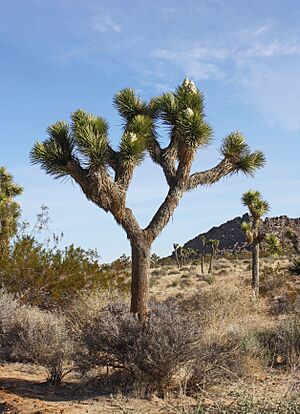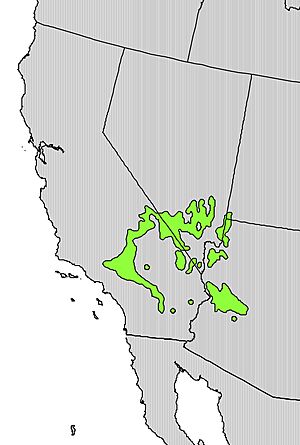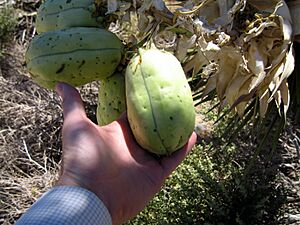Joshua tree facts for kids
Quick facts for kids Joshua tree |
|
|---|---|
 |
|
| In Joshua Tree National Park, California | |
| Conservation status | |
| Scientific classification | |
 |
|
| Natural range in the United States |
The Joshua tree (also called Yucca brevifolia) is a unique plant that looks like a tree. It's part of the Yucca family. These amazing trees grow naturally in the dry Southwestern United States. You can find them in California, Arizona, Utah, and Nevada. They also grow in northwestern Mexico.
Joshua trees mostly live in the Mojave Desert. They prefer elevations between 400 and 1,800 meters (about 1,300 to 5,900 feet). You can see many of them in places like Joshua Tree National Park. Large groups of these trees are also found near Kingman, Arizona. There's even a special road called the Joshua Tree Parkway of Arizona. The name "Joshua tree" is thought to come from an old religious story.
Contents
What's in a Name?
The Joshua tree has a few different names. Indigenous people called it "hunuvat chiy'a" or "humwichawa." In Spanish, it's known as izote de desierto, which means "desert dagger."
The plant was first officially named Yucca brevifolia by George Engelmann in 1871. This happened during a big survey of the American West.
The most common story about the name "Joshua tree" comes from Mormon settlers. They crossed the Mojave Desert in the mid-1800s. The tree's shape, with its branches reaching up, reminded them of a biblical story. In that story, a leader named Joshua held his hands up during a battle. The shaggy leaves might have looked like a beard to them.
How Joshua Trees Grow
Joshua trees grow pretty fast for a desert plant. Young trees can grow about 7.6 centimeters (3 inches) each year for their first 10 years. After that, they slow down to about 3.8 centimeters (1.5 inches) per year.
The trunk of a Joshua tree is made of many small fibers. It doesn't have growth rings like other trees, so it's hard to tell its exact age. These trees have a wide root system. Some roots have been found as far as 11 meters (36 feet) from the tree! If they survive the harsh desert, they can live for hundreds of years. The tallest ones can reach about 15 meters (50 feet) high.
New Joshua trees can grow from seeds. But sometimes, new stems sprout from underground rhizomes. These rhizomes spread out from the parent tree.
Leaves and Flowers
The leaves of a Joshua tree are always green. They are long and pointy, like a bayonet. Each leaf is about 15 to 35 centimeters (6 to 14 inches) long. They are arranged in a tight spiral at the end of the branches. The edges of the leaves are white and have small teeth.
Flowers usually appear from February to late April. They grow in large clusters called panicles. These clusters can be up to 55 centimeters (22 inches) tall. The individual flowers are creamy white to green.
Joshua trees usually don't grow new branches until after they bloom. They also don't bloom every year. Like most desert plants, they need enough rain at the right time to flower. They also need a cold winter freeze before they can bloom.
Life Cycle and Pollination
When the flowers bloom, they are pollinated by a special insect called the yucca moth. The moth lays its eggs inside the flower. As it does this, it spreads pollen from one flower to another. The moth larvae (baby moths) eat some of the seeds. But enough seeds are left for the tree to reproduce.
Where Joshua Trees Live
Joshua trees are found in the southwestern United States. This includes Arizona, California, Nevada, and Utah. They also grow in northwestern Mexico. Their home is mostly the Mojave Desert. They are considered a key plant that shows you are in the Mojave Desert. They grow at elevations between 400 and 1,800 meters (about 1,300 to 5,900 feet).
Protecting Joshua Trees
Joshua trees are facing challenges, especially from climate change. Scientists think that their natural home might shrink a lot by the end of this century. This could change the entire ecosystem of places like Joshua Tree National Park.
Other threats include wildfires and invasive grasses. For example, a huge wildfire in 2020, called the Dome Fire, killed over 1.3 million Joshua trees. This happened in the Mojave National Preserve.
Another concern is how the trees spread their seeds. Thousands of years ago, giant sloths might have helped spread Joshua tree seeds. These sloths are now extinct. However, ground squirrels are very good at moving the seeds around today.
In California, there have been efforts to protect the Western Joshua Tree. In 2023, a new law called the Western Joshua Tree Conservation Act was passed. This law aims to protect these trees and other species that might be threatened by climate change. It also allows for some development in the desert. The law requires a fee if a Joshua tree needs to be removed, moved, or trimmed. This helps fund conservation efforts.
Uses of Joshua Trees
Joshua trees are sometimes grown in gardens. Smaller types of the tree grow about 2.5 meters (8 feet) tall. They start branching when they are about 1 meter (3 feet) tall.
Birds like Red-shafted flickers often build nests in the branches. Other birds then use these nests later.
Long ago, Native American tribes in the Mojave Desert used parts of the Joshua tree. They used the strong fibers from the leaves to make sandals. They also wove root fibers into baskets, adding reddish-brown designs. The fruits were baked or boiled and eaten. Seeds were ground into flour and mixed with other plant flours. This flour was then made into cakes and dried.
See also
 In Spanish: Árbol de Josué para niños
In Spanish: Árbol de Josué para niños





